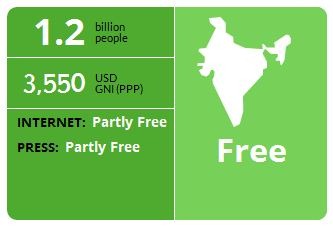Internet freedom in India has been rated as Partly Free by American NGO Freedom House. The report titled Freedom on the Net 2012 measures the levels of freedom and editorial independence enjoyed by populations of various countries in the world.
Despite the Partly Free rating, India was ranked 20th worldwide, ahead of most Asian countries.
The Freedom on the Internet report scored countries on a point scale of 0 to 100 to quantify the freedom enjoyed on online and digital media. Lower scores between 0-30 signified most freedom, 31-60 implied partial freedom while 61-100 implied lack of freedom on the internet. Points were given on the basis of how the government of a country imposed obstacles to internet access, limited or filtered online content or violated user rights by surveillance or other forms of harassment.
The score of 39 attributed to India was driven by 13 points in Obstacles to Access, 9 points on Limits on Content and 17 points for Violation of User Rights. The deterioration from a slightly better score of 36 in 2011 was being driven by a nominal uptick in all the 3 categories.
With more than 100 million people in India finding their way online, India has the 3rd highest online audience in the whole world after US and China.
This signifies an internet penetration rate of about 10%, one of the lowest of all the countries in the report. Lack of broadband penetration, infrastructural limitations, low levels of literacy and bureaucratic inefficiency in licensing were cited as findings that posed as obstacles to internet access.
Despite the hindrances, the report also noted that internet access in India was on the increase as crores of new users were finding their way online every year. The powerful potential of increased internet penetration in rural India is undeniably omnipresent.
Availability of content in local languages, government’s plans to boost broadband infrastructure and a growing mobile user base are set to reduce the urban-rural divide when it comes to internet usage.
Aligning with reports indicating a growth in rural mobile internet users, Freedom House’s findings mentioned "India’s overall mobile phone penetration figures continue to grow at fast speeds, and an increasing number of Indians are also getting online via mobile devices."
Freedom on the Net 2012 also noted that the government’s monitoring, control and censorship of online content in India is on the rise. Recent blocking of content in public interest has been seen as an attempt by the authorities to increase control over online content. Various instances including the arrest of a professor and a cartoonist, and fines imposed on internet companies for not providing customer data have also been mentioned.
The last couple of years have seen a flurry of government activity in the online domain. Google, Facebook, Twitter and other popular online platforms have been summoned by authorities on various occasions.
However there is little denying that anti-social elements are also present online. Hacking attacks on government agencies and public portals, rumour mongering on social media leading to violence and other illicit online activities have emerged. The government cannot be entirely dismissed for its attempts to add structure and framework to an explosively growing domain.
As per the Freedom on the Net 2012 report, India’s point tally of 39 puts it well ahead of many other countries including Indonesia (42), Russia, Sri Lanka (55) and China (85). In fact, Malaysia (43), Russia, Sri Lanka, Libya (43) and Pakistan (63) are in Freedom House’s list of Countries At Risk – implying state policing to a certain extent, with significant restriction, censorship and blocking of websites/content. India ranks behind developed western economies like US (12), Germany (15), Australia (18) and UK (25).
The post Internet freedom: India Ranked 3rd in Asia! appeared first on India Business & Technology Hub.


No comments:
Post a Comment